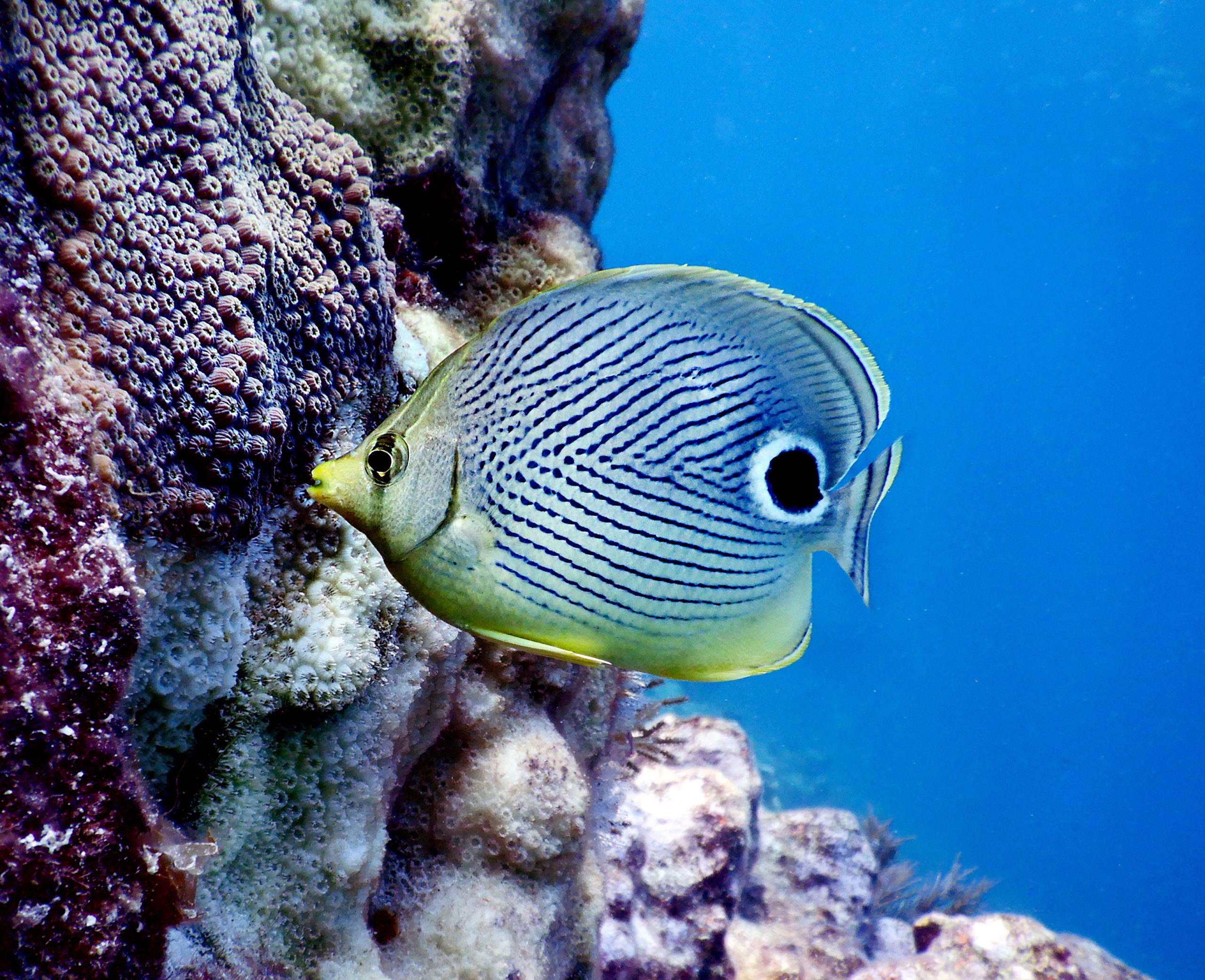
Sea Wonder: Butterfly Fish
 One of the most recognizable reef fish in the ocean, butterflyfish are actually a group of more than 110 species of fish that are part of the family Chaetodontidae. As recently as 2016, a new species of deep-reef butterflyfish was found in Papahānaumokuākea Marine National Monument called Pete Basabe’s Butterflyfish (Prognathodes basabei). This discovery underscores the diversity of coral reefs and the unknown of the ocean. They are brightly colored and have striking patterns that make them popular throughout the aquarium trade.
One of the most recognizable reef fish in the ocean, butterflyfish are actually a group of more than 110 species of fish that are part of the family Chaetodontidae. As recently as 2016, a new species of deep-reef butterflyfish was found in Papahānaumokuākea Marine National Monument called Pete Basabe’s Butterflyfish (Prognathodes basabei). This discovery underscores the diversity of coral reefs and the unknown of the ocean. They are brightly colored and have striking patterns that make them popular throughout the aquarium trade.
Description
Butterflyfish are fairly small, reaching between four and 12 inches long when fully grown, about the size of a teacup. Their bodies are thin and disk-shaped, similar to those of an angelfish, their genetic cousins. Generally, their scales are a mix of vibrant colors and darker bands in various patterns. At night, their bright colors fade to blend in with dark areas of the reef and help them avoid being seen. It is their coloration, shape, and abundance along reefs that make them so popular with snorkelers and divers.
Many species of butterfly fish also have dark patches near their tails and on both sides of the body, which scientists believe may be false eye patches that help deter predators (especially fin-biting ones). Near the front of their bodies, they have pointed mouths full of brush-like teeth. Along their backs is a singular dorsal fin comprised of individual spines and rays, and along their bellies are caudal fins that span about half their body length. In most species of butterfly fish, adult males and females don’t differ in size or color.
Diet & Habitat
Butterflyfish are primarily reef fish (though some live among seagrass beds, mud flats, and near brackish water bays) and they are found in the world’s warm temperate and tropical waters. They generally don’t live deeper than 60 feet down but a handful of deep-water species do exist. Their geographic distribution includes most of the world’s waters, including near Australia and Asia in the Pacific and North and South America in the Atlantic, as well as islands in the Caribbean. In the U.S., butterflyfish range from the Carolinas down to Florida, and along states in the Gulf of Mexico. We see species of butterflyfish in many national marine sanctuaries including American Samoa, Florida Keys, Flower Garden Banks, and Hawaiian Islands Humpback Whale and Marine National Monuments including Papahānaumokuākea and Rose Atoll.
Butterflyfish are daytime feeders that travel in pairs or small schools. Using their clear vision to find prey, they will use visual cues to communicate to their conspecifics when they have found food. Using their pronounced jaws, butterflyfish graze on organisms that can hide in smaller crevices in the marine environment, including small invertebrates, polychaete worms, and even sponges. Some species even eat zooplankton, sea grass, and coral polyps. Their specific diet dictates the shape and use of their jaw, with shorter jaws helping to nip tissue off of a coral polyp and longer, thinner jaws useful for tweezing animals out from their hiding spots. Experts believe butterflyfish coevolved with other organisms in their ecosystems and play an important part in maintaining the health of their habitat by keeping algae from smothering coral, keeping invertebrate populations in balance, making room for new growth, and removing dead or dying tissue from sponges and corals.
Life History
Butterflyfish generally live upwards of three years. Females lay the most eggs in the later winter, early spring, and even the very early summer months, with larvae hatching less than two days later. Juveniles experience several life stages and change shape in each before reaching adulthood at around a year old, the same time they reach sexual maturity.
Butterflyfish are pair-bonding monogamous species, meaning they find a mate and remain together for life. They reproduce by spawning – a behavior in which eggs and sperm are released into the water column for fertilization – which generally happens at dusk during the breeding season. Once fertilized, the eggs are at the mercy of the water currents, settling randomly and hatching if the conditions are right and they aren’t eaten along the way. Juveniles and adults may travel in small schools but are generally solitary until they find a partner with whom to mate. These fish are highly territorial and experts don’t know much about their mating rituals.
Threats & Conservation
Butterflyfish are not targeted for commercial or recreational purposes though they are popular in the aquarium trade and can be caught as bycatch (the accidental capture of a species that is not the target species). At least five species are listed as vulnerable to extinction with other species being forced to adapt to a changing ocean environment. Climate change, reef degradation, ocean acidification, coastal development, and higher volumes of reef tourism activities put pressure on butterfly fish populations and their homes. This family of fish does not currently receive special protections under conservation laws.

